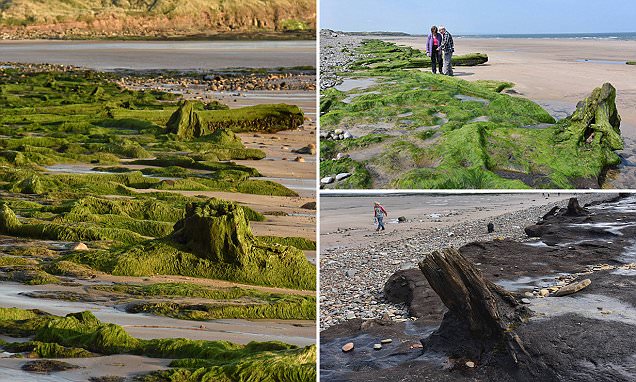North sea reveals forest buried for 7,000 years and human footprints
The surge and flood of the North Sea have uncovered an archeological mystery of the Britain past – the remains of hunter-gatherers chasing wildlife through a long-lost wood. An ancient woodland, dating more than 7,000 years and submerged under the sand for centuries, is slowly uncovered by the ocean.

Tree stumps and felled logs, which have been preserved by peat and sand, are now clearly visible along with a 650 feet (200 meters) stretch of coastline at Low Hauxley near Amble, Northumberland.
Studies of the ancient forest, which existed at a time when the sea level was much lower and Britain had only recently separated from what is now mainland Denmark, have revealed it would have consisted of oak, hazel and alder trees.
The forest first began to form around 5,300 BC but by 5,000 BC the encroaching ocean had covered it up and buried it under the sand. Now the sea levels are rising again, the remnants of the forest are becoming visible and being studied by archaeologists.
Rather than a continuous solid landmass, archaeologists believe Doggerland was a region of low-lying bogs and marshes that would have been home to a range of animals, as well as the hunter-gatherers which stalked them.
But the relatively rapid change in the surrounding environment would have gradually confined animals and humans in the region to Europe and the UK as the bogs and marshes became flooded, making them impassable.
Doctor Clive Waddington, of Archaeology Research Services, said: ‘In 5,000 BC the sea level rose quickly and it drowned the land. The sand dunes were blown back further into the land, burying the forest, and then the sea receded a little.

The sea level is now rising again, cutting back the sand dunes, and uncovering the forest. The forest existed in the late Mesolithic period, which was a time of hunting and gathering for humans.
In addition to tree stumps, archaeologists say they have uncovered animal footprints, highlighting the diverse wildlife which would have roamed the ancient Doggerland forest.
Dr. Waddington, who says evidence has been discovered of humans living nearby in 5,000 BC, added: ‘On the surface of the peat we have found footprints of adults and children.
‘We can tell by the shapes of the footprints that they would have been wearing leather shoes.
‘We have also found animal footprints of red deer, wild boar, and brown bears.’
A similar stretch of ancient forest was uncovered in 2014 near the village of Borth, Ceredigion, in Mid Wales after a spate of winter storms washed away the peat preserving the area.
Peat is able to preserve trees and even the bodies of animals so well because it is so low in oxygen, effectively choking the microbes which break down organic matter, so preserving their organic contents for thousands of years.
But in coastal regions where ancient forests have been long preserved in peat, such as in Wales and Northumberland, the rising seas are washing away this layer and exposing remnants from Britain’s past.



